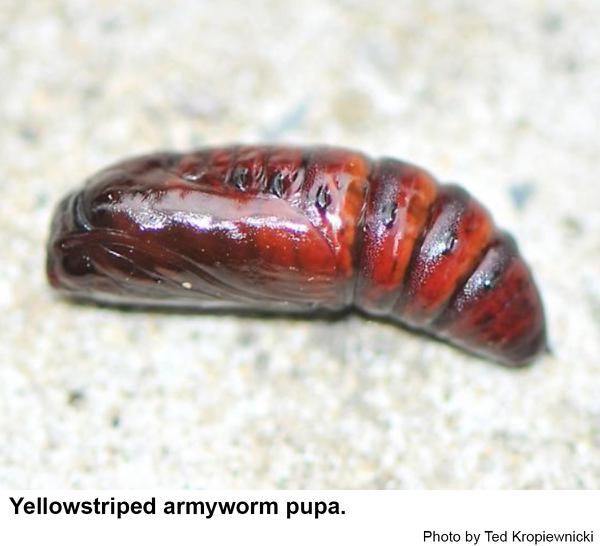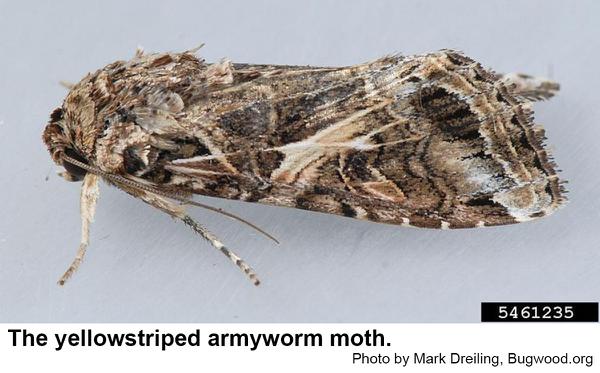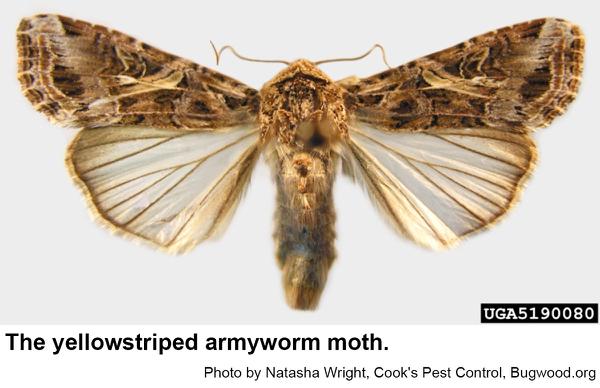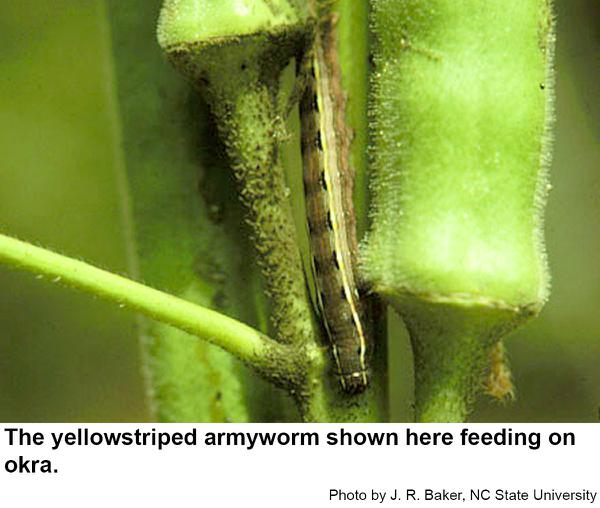Description and Biology
The yellowstriped armyworm, Spodoptera ornithogalli, is a general feeder on herbaceous plants. It is smooth, pale gray to jet black with a yellowish-orange stripe along each side and a pair of black, triangular spots on top of most segments. The sixth stage may be as long as 1¾ inches. The reddish-brown pupa is about 5/8 inch long, cylindrical, and slightly pointed at the rear. Yellowstriped armyworm moths have dark forewings mottled with white and brown markings. The hind wings are pale with a narrow dark line near the margin. Wingspans range up to 1½ inches. Females lay up to 3,000 eggs with as many as 500 eggs in one mass. Each egg is tiny and has microscopic ribs. Greenish at first, eggs gradually become pale pink to brown before hatching. The egg mass is covered with scales from the moth's body. Yellowstriped armyworms overwinter as pupae in the soil. Moths emerge from the soil from early April into May. After mating, females deposit egg masses on foliage, trees, or even buildings. About six days later, the eggs hatch and the tiny, new caterpillars begin feeding in groups but split up as they mature. Yellowstriped armyworms feed during the day on tender foliage for about three weeks. When mature they burrow into the soil and molt into pupae. Two weeks later, a second generation of moths emerge. Development from egg to moth takes about 40 days. We have three to four generations each year North Carolina.
Host Plants
Yellowstriped armyworms feed on many herbaceous plants including ornamentals, alfalfa, asparagus, bean, beet, cabbage, corn, cotton, cucumber, tomato, weeds, and wild onion.
Residential Recommendations
Several parasitic wasps and flies, diseases, predaceous insects, and other predators help to limit yellowstriped armyworm populations. Because they feed on many plants that are never sprayed with insecticides, this species is probably not resistant to pesticides. Most insecticides labeled for home landscape use should give more than adequate control. Those with Bacillus thuringiensis as the active ingredient work best on very young caterpillars.
References
- Common name: yellowstriped armyworm, scientific name: Spodoptera ornithogalli (Guenée) (Insecta: Lepidoptera: Noctuidae). Capinera, J. L. 2001. Featured Creatures. Entomology & Nematology, FDACS/DPI, EDIS, Publication Number: EENY- 216.
- Insect and related pests of vegetables. Sorensen, K. A. and J. R. Baker eds. 1994. North Carolina Agricultural Extension Service publication AG-295. 180 pp.
- Yellowstriped Armyworm, Spodoptera ornithogalli (Guenée). Bessin, R. 2019. University of Kentucky Extension Service. ENTFACT-321
- Extension Plant Pathology Publications and Factsheets
- Horticultural Science Publications
- North Carolina Agricultural Chemicals Manual
For assistance with a specific problem, contact your local Cooperative Extension Center.
This Factsheet has not been peer reviewed.
Publication date: Feb. 6, 2017
Reviewed/Revised: Nov. 13, 2021
Recommendations for the use of agricultural chemicals are included in this publication as a convenience to the reader. The use of brand names and any mention or listing of commercial products or services in this publication does not imply endorsement by NC State University or N.C. A&T State University nor discrimination against similar products or services not mentioned. Individuals who use agricultural chemicals are responsible for ensuring that the intended use complies with current regulations and conforms to the product label. Be sure to obtain current information about usage regulations and examine a current product label before applying any chemical. For assistance, contact your local N.C. Cooperative Extension county center.
N.C. Cooperative Extension prohibits discrimination and harassment regardless of age, color, disability, family and marital status, gender identity, national origin, political beliefs, race, religion, sex (including pregnancy), sexual orientation and veteran status.





